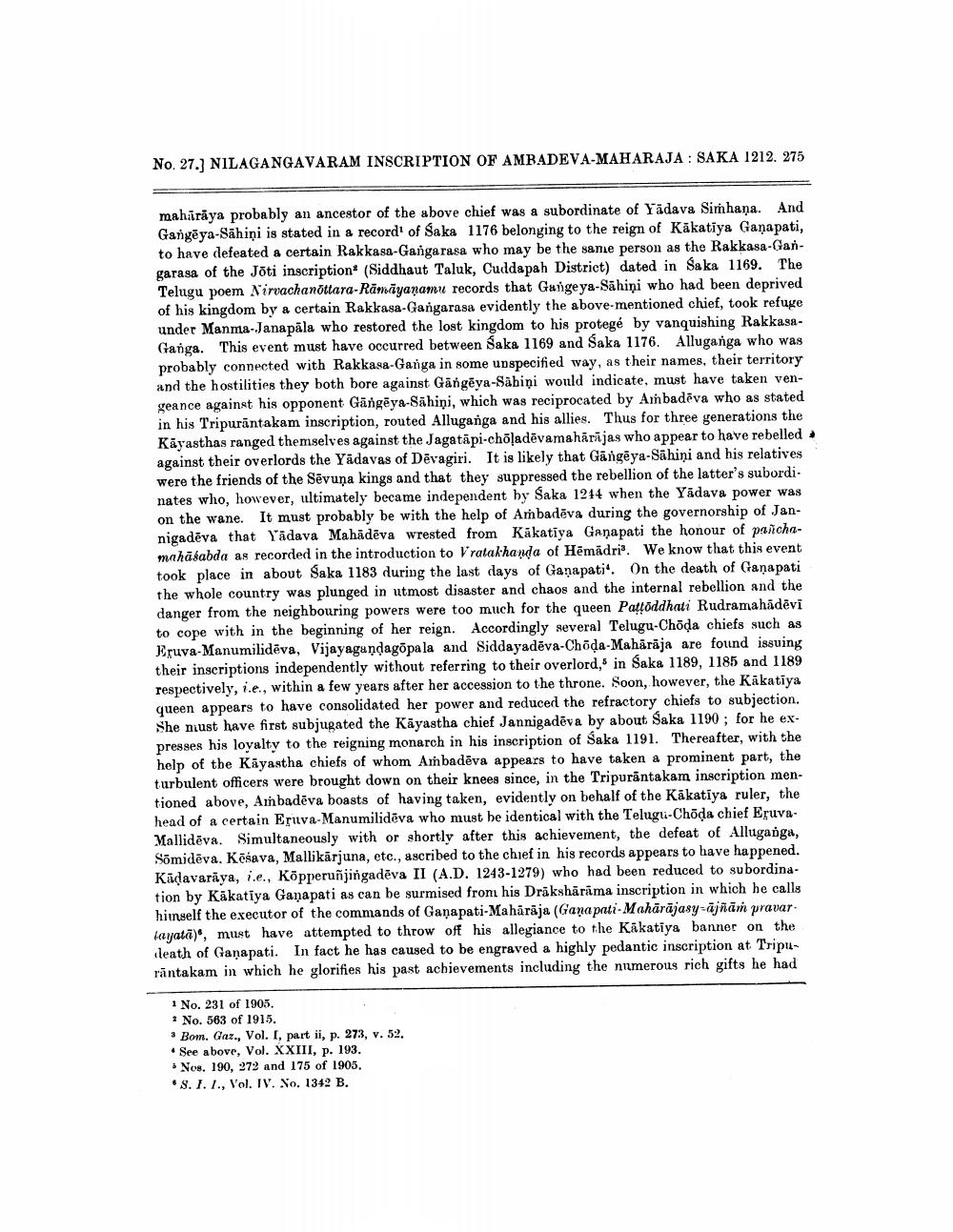________________
No. 27.) NILAGANGAVARAM INSCRIPTION OF AMBADEVA-MAHARAJA : SAKA 1212. 275
maharaya probably an ancestor of the above chief was a subordinate of Yadava Simhana. And Gangěya-Sähini is stated in a record of Saka 1176 belonging to the reign of Kakatiya Ganapati, to have defeated a certain Rakkasa-Gangarasa who may be the same person as the Rakkasa-Gangarasa of the Joti inscription" (Siddhaut Taluk, Cuddapah District) dated in Saka 1169. The Telugu poem Nirvachanottara-Rāmāyanamu records that Gangeya-Sāhiņi who had been deprived of his kingdom by a certain Rakkasa-Gangarasa evidently the above-mentioned chief, took refuge under Manma-Janapala who restored the lost kingdom to his protege by vanquishing RakkasaGanga. This event must have occurred between Saka 1169 and Saka 1176. Alluganga who was probably connected with Rakkasa-Ganga in some unspecified way, as their names, their territory and the hostilities they both bore against Gangéya-Sābiņi would indicate, must have taken vengeance against his opponent Gängēya-Sähini, which was reciprocated by Aunbadēva who as stated in his Tripurāntakam inscription, routed Alluganga and his allies. Thus for three generations the Käyasthas ranged themselves against the Jagatäpi-chõladēvamahārājas who appear to have rebelled. against their overlords the Yadavas of Dēvagiri. It is likely that Găngēya-Sāhiņi and his relatives were the friends of the Sēvuņa kings and that they suppressed the rebellion of the latter's subordi. nates who, however, ultimately became independent by Saka 1244 when the Yādava power was on the wane. It must probably be with the help of Ambadēva during the governorship of Jan. nigadēva that Yādava Mahādēva wrested from Kakatiya Ganapati the honour of panichamahāśabda as recorded in the introduction to Vratakhanda of Hēmädril. We know that this event took place in about Saka 1183 during the last days of Ganapati. On the death of Ganapati the whole country was plunged in utmost disaster and chaos and the internal rebellion and the danger from the neighbouring powers were too much for the queen Patroddhati Rudramahādēvi to cope with in the beginning of her reign. Accordingly several Telugu-Chöda chiefs such as Kuva-Manumilidēva, Vijayagandagopala and Siddayadēva-Choda-Mahārāja are found issuing their inscriptions independently without referring to their overlord, in Saka 1189, 1185 and 1189 respectively, i.e., within a few years after her accession to the throne. Soon, however, the Kakatiya queen appears to have consolidated her power and reduced the refractory chiefs to subjection. She niust have first subjugated the Kāyastha chief Jannigadēva by about Saka 1190 ; for he expresses his loyalty to the reigning monarch in his inscription of Saka 1191. Thereafter, with the help of the Kāyastha chiefs of whom Ambadēva appears to have taken a prominent part, the turbulent officers were brought down on their knees since, in the Tripurantakam inscription mentioned above, Anbadēva boasts of having taken, evidently on behalf of the Kakatiya ruler, the head of a certain Eruva-Manumilidēva who must be identical with the Telugu-Chōda chief Eruva. Mallidēva. Simultaneously with or shortly after this achievement, the defeat of Alluganga, Sömidēva. Kēšava, Mallikarjuna, etc., ascribed to the chief in his records appears to have happened. Kādavaraya, i.e., Köpperunjingadēva II (A.D. 1243-1279) who had been reduced to subordination by Kakatiya Ganapati as can be surmised from his Drākshärama inscription in which he calls himself the executor of the commands of Ganapati-Mahārāja (Ganapati-Mahārājasy-ajñām pravar layatā), must have attempted to throw off his allegiance to the Kakatiya banner on the leath of Ganapati. In fact he has caused to be engraved a highly pedantic inscription at Triple rāntakam in which he glorifies his past achievements including the numerous rich gifts he had
1 No. 231 of 1905.
No. 563 of 1915. • Bom. Gaz., Vol. I, part ii, p. 273, v. 52. • See above, Vol. XXIII, p. 193.
Nos. 190, 272 and 175 of 1905. .8.1. I., Vol. IV. So. 1342 B.




